Types of Cooperatives
Cooperatives vary depending on the service offered and the way that the members are organized. They also differ depending on the economic activity, how members use the Cooperative and kind of management.
There are six types of classification: Agricultural Co-op (known in Manitoba “New Generation Co-op”), Consumer Co-op, Credit Union, Housing Co, and insurance Co-op and Worker co-ops. Those types of cooperatives include producer/marketing, retail supply, utilities, cable television, agricultural services, fish marketing, child care, farmers' markets and community service.
- Producer / Marketing Cooperatives
- Consumer Cooperatives
- Worker Cooperatives
- Housing Cooperatives
- Financial Cooperatives
- New Generation Cooperatives
- Multi-Stakeholder Cooperatives
- Non-profit Community Service Cooperatives
Producer / Marketing Cooperatives
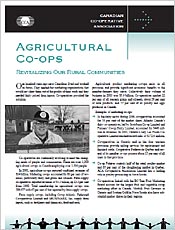 The Producer Co-ops were one of the first kinds of Cooperatives developed to explore and provide solutions to the farmers’ production in the early 1880s. Producers Co-ops are also known as marketing co-op where the members provide the co-op with the same production that the co-op markets in a processed or value-added form.
The Producer Co-ops were one of the first kinds of Cooperatives developed to explore and provide solutions to the farmers’ production in the early 1880s. Producers Co-ops are also known as marketing co-op where the members provide the co-op with the same production that the co-op markets in a processed or value-added form.
The Co-ops’ mandate is to commercialize the members input by seeking the best price possible on the market. In Manitoba many groups of suppliers are organized into marketing co-ops to meet the marketing requirement and to explore and access the market for their product.
These Producer Co-ops include farmers, artists, harvesters and fishers seeking out and selling to end users to earn and retain the benefit of their owners/producers.
For more information please read about Agricultural Co-ops in this article by the Canadian Cooperative Association (PDF).
Consumer Cooperatives
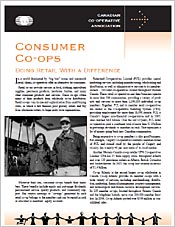 This is one of the best known forms of cooperatives. They are owned and controlled by the people that buy the products and services sold, managed or distributed by the co-ops.
This is one of the best known forms of cooperatives. They are owned and controlled by the people that buy the products and services sold, managed or distributed by the co-ops.
Their mandate is to acquire the products and services required by their members at the lowest possible cost with the highest possible quality. These co-ops can operate in three different ways; as buying clubs where products and services are obtained by the co-op only when the members place an order; as retail stores where the members come in to shop; and as service providers where members order the service, such as cable television, internet access, insurance, water or natural gas.
In Manitoba there are general stores, gas bars, farm supplies, furniture stores, funeral services, natural gas utilities, water utilities, internet access and cable television co-ops serving the needs of their members.
For more information please read about Consumer Cooperatives (PDF).
Worker Cooperatives
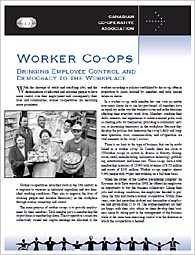 Worker co-ops are identified as the third type of Cooperative owned and controlled by their employees. The purpose of the worker co-op is to create jobs for their members and allow them control of their workplace. Members provide the capital to finance the business, each sharing the costs and risks of ownership.
Worker co-ops are identified as the third type of Cooperative owned and controlled by their employees. The purpose of the worker co-op is to create jobs for their members and allow them control of their workplace. Members provide the capital to finance the business, each sharing the costs and risks of ownership.
The management of a worker co-op is concentrated in the business part and classified as a third type of co-op where the members are employees.
Usually the worker co-ops are services co-op offering services to other business and they are generally printing, nursery schools, cleaning, consulting, delivery, manufacturing and food services.
Major benefits to the employee-members include involvement in the policy-making process, through the election of a Board of Directors, profit sharing through patronage allocations, and a quality of work life that is established by the membership.
For more information please read about Worker Cooperatives (PDF).
Housing Cooperatives
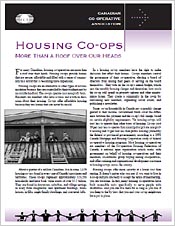 Housing co-ops are developed to resolve the living need by offering an affordable and secure housing in a viable community. The members are tenants/owners having the ability to manage and control the co-op.
Housing co-ops are developed to resolve the living need by offering an affordable and secure housing in a viable community. The members are tenants/owners having the ability to manage and control the co-op.
There are two types of housing co-ops under Manitoba legislation, “Not-for profit” (a defined term) and all others.
Not-for-profit housing co-ops are those where Articles of Incorporation specify that they are not-for-profit, that file income tax returns as a not-for-profit corporation or that have received from the Government of Canada or the Government of Manitoba or an agency of either one of them, a subsidy or assistance of a type that assisted with or reduced housing costs.
The Not-for-profit housing co-ops are subject to the following restrictions:
- They cannot issue investment shares
- They must conduct at least 90% of their business with their members
- They shall carry on their business without the purpose of gain for their members
- They may not be continued under any other legislation
- They may not amend their articles to change to any other type of co-op
- On dissolution their remaining assets must be given to:
- another not-for-profit housing co-op
- a Manitoba co-op with similar objectives and limitations
- charitable organizations with similar purposes
Most housing co-ops in Manitoba are not-for-profit and were built with assistance from both the Government of Canada and the Government of Manitoba to provide affordable housing for low and moderate income families.
Resident members purchase membership shares of the co-op in relatively small amounts (less than three months housing charges) and pay housing charges to cover mortgage interest, utilities, repairs, taxes, depreciation, management, administrative and other operating costs.
When members leave the co-op they are entitled to have their shares redeemed by the co-op for the same price paid by the members unless the co-op has a deficit and is prevented by legislation from redeeming the shares.
The other category of housing co-ops does not have the above restrictions and set their own rules for the amount of equity required to become a resident member and how members deal with their occupancy rights and shares when leaving.
In most instances the exiting member gives the prescribed notice and on the exit date is no longer responsible for the housing charges and receives the acquisition price for the membership shares upon redemption less any pro rata portion of any capital impairment. In some of these co-ops the share capital is modest and similar to the not-for-profit housing co-ops and the co-op and the members’ cash flows are not significant. Other equity requirements are higher and members can reduce the monthly housing charges by increasing the share capital investment.
However, upon leaving, the housing co-op may have to increase its mortgage, as the incoming member may not be able to invest as much in share capital as the exiting member. In these cases the exiting member may have to wait some time before being paid for all the shares redeemed. This can also put stress on the co-op if the mortgage holder does not feel the cash flow of the co-op is sufficient to warrant additional financing. Others are set up so that the exiting member is responsible for the housing charges until a replacement resident member is found.
The new member pays the exiting member market value for the right to occupy the housing unit and the housing co-op records the transfer of equity and charges the new member an initiation fee. The housing co-op, although it still must approve the new member, receives the transfer fee but does not have to concern itself with the redemption of shares.
For more information please read about Housing Cooperatives (PDF).
Financial Cooperatives
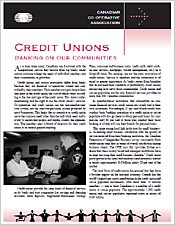 The financial co-ops were initially based on consumer co-ops offering financial services to their members. Financial co-ops were started in rural communities providing farmers with micro credit during the early 1900s and they were known as the people’s bank or credit unions, and saving and credit cooperatives.
The financial co-ops were initially based on consumer co-ops offering financial services to their members. Financial co-ops were started in rural communities providing farmers with micro credit during the early 1900s and they were known as the people’s bank or credit unions, and saving and credit cooperatives.
These special types of co-ops often come under legislation developed for the uniqueness of the financial services being provided to their members, deposit taking, loans, trust services, and insurance. Credit Unions (in English Canada) / Caisses Populaire (French Canada) are the most recognizable or best known of the financial co-ops. Like other co-ops democratic control is in the hands of their members/owners.
These co-ops have the mandate to provide their members with financial services at the lowest possible cost and the highest possible return. These services include a variety of deposit vehicles, mortgages, loans, lines of credit, safety deposit boxes, financial planning, estate administration and insurance.
In Manitoba, Credit Unions and Caisses Populaires are incorporated under The Credit Unions and Caisses Populaires Act.
For more information please read about Financial Cooperatives (PDF).
New Generation Cooperatives
New Generation cooperative or New Formula to view and operate a Co-op and they are the latest buzzwords in the co-op community describing a variation on the traditional co-op, yet, retaining the critical co-op principles. New Generation Cooperatives (NGCs) represent an emerging trend in agriculture, forestry, fishing and other industries that are supplied by producers. These are distinct types of cooperatives formed to enable members to process raw commodities. As a result, members not only receive market prices for their produce, they also gain the opportunity to profit from processing and marketing these value-added products.
It is primarily the financial structure and membership requirements that distinguish NGCs from the more traditional cooperatives. Typically, higher equity investments are required by members in order to establish a processing plant. Furthermore, the number of members is limited to those who purchase delivery rights, as well as by the processing capacity of the plant. Because of the unique structure of NGCs, members feel a greater degree of personal ownership and a stronger commitment to the cooperative.
These Cooperatives are referred to as new generation because of four distinct variances from traditional co-ops:
- The focus is on the value-added processing or manufacturing of raw commodities delivered to the co-op by its members and the marketing of the resulting products.
- A significant equity investment is required by each member, with the total initial equity contribution being a major portion of the gross project costs.
- A two-way contract between the member and the co-op requires each member to deliver, and the co-op to accept, an agreed-upon amount of the raw commodity for each delivery right (special investment share under Manitoba legislation) owned by the member.
- Membership is limited to the number of special investment shares (delivery rights) required to be sold by the co-op to its members in order to meet its processing capacity.
For more information please read about New Generation Co-ops (PDF).
Multi-Stakeholder Cooperatives
The Manitoba government amendments to the Cooperatives Act will allow groups that normally form separate co-ops, such as workers and consumers, to combine their resources and create a co-op together. This allows co-ops greater strength and sustainability with the ability to diversify their stakeholders.
Non-profit Community Service Cooperatives
Provides services to the community on a not for profit basis, for example a child care centre owned and operated by the parents using the centre.



